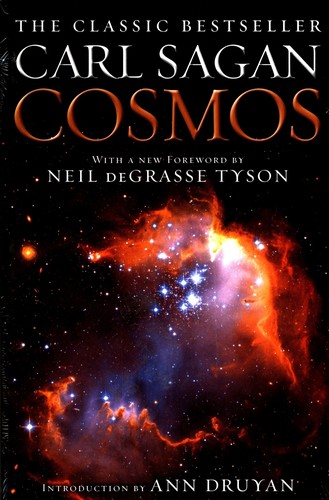Introduction
“Cosmos” by Carl Sagan is a seminal work that delves into the vastness of the universe, the emergence of life on Earth, and the trajectory of human civilization. This book is not only a scientific exploration but also a philosophical inquiry into our place in the cosmos. Sagan’s ability to blend scientific insights with profound philosophical questions has made “Cosmos” a timeless classic.
Core Frameworks and Concepts
At the heart of “Cosmos” is a framework that examines the universe through three primary lenses: scientific inquiry, cosmic evolution, and human significance. Each lens offers a unique perspective on our universe and our role within it.
1. Scientific Inquiry
Sagan champions the scientific method as the most powerful tool for understanding the cosmos. This involves observation, hypothesis formation, experimentation, and validation. He compares the scientific method to a strong lighthouse, guiding humanity through the darkness of ignorance.
Example: Sagan explains how early astronomers, using rudimentary tools, discovered the heliocentric nature of our solar system, which revolutionized our understanding of our place in the universe. This mirrors modern scientific advancements, such as the discovery of exoplanets using sophisticated telescopes.
2. Cosmic Evolution
Cosmic evolution traces the history of the universe from the Big Bang to the present. Sagan outlines the stages of cosmic development, emphasizing the interconnectedness of all matter.
Example: Sagan draws an analogy between the universe and a growing organism, where stars are born, live, and die, contributing elements that form planets and, eventually, life. This concept is echoed in “The Elegant Universe” by Brian Greene, which also explores the intricate dance of cosmic forces.
3. Human Significance
Sagan explores the philosophical implications of our existence in a vast universe. He challenges readers to find meaning and purpose in the face of our cosmic insignificance.
Example: Echoing themes in “Pale Blue Dot,” Sagan urges us to recognize Earth’s fragility and the importance of stewardship. This is akin to the environmental call-to-action found in Rachel Carson’s “Silent Spring.”
Key Themes
1. The Interconnectedness of Life
Sagan emphasizes the unity of all life, tracing our origins to the same cosmic events that formed the stars. He argues that understanding this interconnectedness is crucial for the survival of our species.
Example: He likens the Earth to a single organism, with humans as a part of a larger cosmic ecosystem. This theme resonates with James Lovelock’s Gaia theory, which views Earth as a self-regulating system.
2. The Importance of Scientific Literacy
Sagan advocates for widespread scientific literacy, arguing that it is essential for informed decision-making in a technologically advanced society.
Example: He compares scientific literacy to a compass in a world filled with misinformation, enabling individuals to navigate complex societal challenges. This is a sentiment echoed by Neil deGrasse Tyson in “Astrophysics for People in a Hurry.”
3. The Role of Skepticism
Sagan introduces skepticism as a vital component of scientific inquiry, essential for combating pseudoscience and unfounded claims.
Example: He uses the analogy of a courtroom, where evidence must be scrutinized before drawing conclusions. This approach is supported by Michael Shermer’s “The Believing Brain,” which examines how beliefs are formed and maintained.
4. The Search for Extraterrestrial Life
The possibility of extraterrestrial life is a recurring theme in “Cosmos.” Sagan explores the scientific methods used to search for life beyond Earth.
Example: He likens the search for extraterrestrial life to a needle-in-a-haystack puzzle, with each new discovery bringing us closer to solving it. This quest is further explored in Stephen Hawking’s “The Universe in a Nutshell.”
5. The Future of Humanity
Sagan contemplates the future of human civilization, advocating for space exploration and the continuation of scientific endeavors.
Example: He compares humanity to a fledgling species, standing on the brink of a new era of exploration. This vision aligns with Elon Musk’s ambitions for Mars colonization, as outlined in “Elon Musk: Tesla, SpaceX, and the Quest for a Fantastic Future” by Ashlee Vance.
Final Reflection
“Cosmos” is more than just a book about science; it is a profound meditation on humanity’s place in the universe. Sagan’s work encourages us to embrace our curiosity and to seek understanding beyond the confines of our immediate environment. By drawing connections between the micro and the macro, “Cosmos” challenges us to see the bigger picture, where every atom in our bodies traces its history to the stars.
In synthesizing the themes of scientific inquiry, cosmic evolution, and human significance, Sagan’s “Cosmos” resonates across disciplines, from philosophy and environmental science to leadership and innovation. Leaders in any field can draw inspiration from Sagan’s dedication to curiosity and exploration, applying these principles to drive positive change and foster a culture of continuous learning.
Ultimately, “Cosmos” is an invitation to reflect on our shared existence and to consider the legacies we wish to leave for future generations. As we stand on the precipice of new technological and scientific frontiers, Sagan’s vision remains as relevant as ever, urging us to strive for a deeper understanding of the universe and our place within it.

